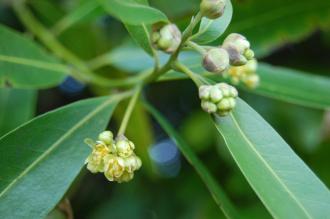
Umbellularia californica Flower (21/01/2012, Kew, London)
Position: Full Sun
Flowering period: Spring
Soil: Moist, well drained
Eventual Height: 30m
Eventual Spread: 12m
Hardiness: 7b – 10b
Family: Lauraceae
Umbellularia californica is a large dome shaped, evergreen tree. Its shiny leaves are oblong to lanceolate, smooth, have a short petiole and up to 10cm long. They are fragrant when crushed. The bark of the tree is smooth and is gray/ brown in colour, maturing to a red/ brown. The trunk of this tree may achieve a diameter of up to 80cm. The inconspicuous flowers of the plant are monoecious, perfect, yellow in color and produced in small umbels. The fruit of the tree (commonly know as the ‘California Bay Nut’) is a drupe, generally solitary, up to 2.5cm long, round to ovoid in shape, initially green with yellow spots maturing to purple. It resemble an olive.
Umbellularia californica, commonly known as Oregon Myrtle, California Bay Laurel, Spicebush, Peppernut Tree, Headache Tree and Pepperwood, is native to the western coast of the USA. In its natural habitat it is found at altitudes from sea level up to 1600m. A specimen was planted in Kew Gardens in 1988 by HRH Princess Alexandra following the ‘Great Storm’ of 16th October 1987 (the specimen photographed here). It is the sole species in the Genus Umbellularia. As could be assumed from the common names for this tree it had a wide range of uses by the Native Americans. This plant can be used in cooking in a similar way to the Bay Tree. This tree is a folia host for sudden Oak Death.

Umbellularia californica (21/01/2012, Kew, London)
The etymological root of the binomial name Umbellularia is derived from the Latin meaning a little shade, in reference to the flowers. Californica is derived from the Latin meaning ‘from California’.
The landscape architect may find Umbellularia californica useful as an attractive evergreen ornamental tree. It may also be used as a hedging species. It may also be grown as a culinary species.
Ecologically, U. californica is attractive to birds for its fruit. It is also used by wildlife as cover for wildlife.
U. californica prefers moist, fertile, well-drained soils. It tolerates most pH of soil.
U. californica requires little maintenance.
Advertisement
